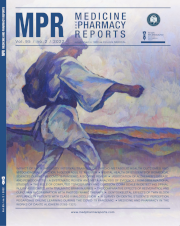Causes of revision after total hip arthroplasty in an orthopedics and traumatology regional center
DOI:
https://doi.org/10.15386/mpr-2136Keywords:
total hip replacement, arthroplasty, aseptic loosening, prosthesis failureAbstract
Background and aim. Despite the great success of primary total hip arthroplasty (THA), the number of revisions has significantly increased over the past years. The objectives of the study were to investigate the main causes that lead to revision of THA, the time interval between primary THA and revision, and the results of the revision surgery. We also assessed whether there was any correlation between the patients’ age, BMI, diagnosis for primary THA and the cause of failure.
Methods. This paper retrospectively analyzed 189 patients with THA revision surgery performed over a six-year period, between 2015 and 2020. Patients’ charts were reviewed to collect data on patient’s demographics, patient's primary THA and revision procedures, and the time interval between primary THA and revision surgery. Patients were divided into 3 groups according to the time interval THA-revision: group I (<5 years), group II (5-10 years) and group III (>10 years).
Results. The patients’ mean age (82 men/107 women) was 69.59±7.85 years (range 31-92 years). The most frequent revision cause was aseptic loosening (52%), followed by periprosthetic fractures (18%), infection (17%) and persistent hip instability (12%). Patients' age (r=0.43) and BMI (r=-0.4) had low correlation with the time interval between THA and revision.
Conclusions. The main causes for revision THA within less than five years are infection and instability, while revision for aseptic loosening is performed especially after five years from the primary THA. Osteonecrosis, post-traumatic osteoarthritis and femoral neck fracture are correlated with a higher incidence of revision at less than five years from the primary THA
Downloads
Published
How to Cite
Issue
Section
License
The authors are required to transfer the copyright of the published paper to the journal. This is done by agreeing to sign the Copyright Assignment Form. Whenever the case, authors are also required to send permissions to reproduce material (such as illustrations) from the copyright holder.

The papers published in the journal are licensed under a Creative Commons Attribution-NonCommercial-NoDerivatives 4.0 International License.

